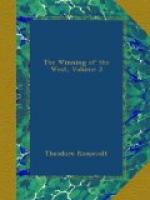The ordinance established a territorial government, with a governor, secretary, and judges. A General Assembly was authorized as soon as there should be five thousand free male inhabitants in the district. The lower house was elective, the upper house, or council, was appointive. The Legislature was to elect a territorial delegate to Congress. The governor was required to own a freehold of one thousand acres in the district, a judge five hundred, and a representative two hundred; and no man was allowed to vote unless he possessed a freehold of fifty acres. [Footnote: “St. Clair Papers,” ii., 603.] These provisions would seem strangely undemocratic if applied to a similar territory in our own day.
Features of the Ordinance of 1787.
The all-important features of the ordinance were contained in the six articles of compact between the confederated States and the people and states of the territory, to be forever unalterable, save by the consent of both parties. The first guaranteed complete freedom of worship and religious belief to all peaceable and orderly persons. The second provided for trial by jury, the writ of habeas corpus, the privileges of the common law, and the right of proportional legislative representation. The third enjoined that faith should be kept with the Indians, and provided that “schools and the means of education” should forever be encouraged, inasmuch as “religion, morality, and knowledge” were necessary to good government. The fourth ordained that the new states formed in the Northwest should forever form part of the United States, and be subject to the laws, as were the others. The fifth provided for the formation and admission of not less than three or more than five states, formed out of this northwestern territory, whenever such a putative state should contain sixty thousand inhabitants; the form of government to be republican, and the state, when created, to stand on an equal footing with all the other States.




